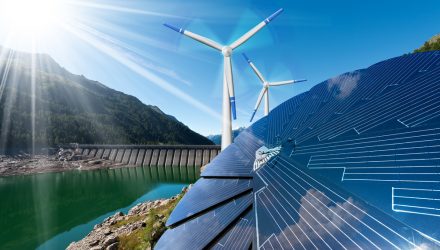Even before environmental, social, and governance (ESG) became a hot buzzword in the financial market’s lexicon, Virtus Investment Partners was already delving into one of its main initiatives—clean energy investments set on reducing the world’s carbon footprint. As such, exchange-traded fund (ETF) investors may want to give the Virtus Reaves Utilities ETF (UTES) a closer look.
UTES seeks to provide alpha via a combination of capital appreciation and income. Using an active management strategy, the only actively managed fund in the utilities space, UTES invests not less than 80% of its net assets in equity securities of companies in the utility sector.
In order for a company to be included as part of its holdings, at least 50% of the company’s assets or customers must be committed to, or at least 50% of the company’s revenues, gross income or profits derived from, the provision of products, services or equipment for the generation or distribution of electricity, gas or water.
For Virtus Investment Partners, the choice to offer an ETF product was an easy one. With over 2,000 ETFs in the marketplace, this is obviously where there’s unprecedented growth in the capital markets.
“The ETF was really an acknowledgment of ‘this is the future of the industry,’” said Reaves Asset Management CEO Joseph “Jay” Rhame, III.
When getting renewable or alternative energy exposure, ETF investors can opt to go for pure plays like the Invesco Solar ETF (NYSEArca: TAN) for solar energy or the First Trust Global Wind Energy ETF (NYSEArca: FAN) for wind energy. However, investing in utilities gives UTES investors its own distinct advantages, particularly when it comes to alternative energy plays.
“We actually think that utilities are the best way, we believe, to play the renewable energy market,” said Rhame. “We think that especially on a risk-adjusted basis, it’s going to drive growth for the industry for a long time, and it’s popular with regulators.”
Furthermore, by investing strictly in utilities, investors can avoid the challenges that can saddle solar panel or wind propeller manufacturers. From price decreases to technological advances of competitors, it can be difficult to gain a long-term edge from a manufacturing perspective.
“On the utilities side, the benefit is when they make an investment, they can put it into their rate base and they earn a return on their invested capital over a 30-year period,” said Rhame. “If they put in $1 billion, they can earn a 10% return on their equity for the next 30 years regardless of if their next panel is cheaper or more expensive, so they don’t really have that technology risk.”
In terms of advantages for renewable energy, Rhame cites that companies can reduce costs by shutting down nuclear plants and coal plants, which pulls the heartstrings of investors who are clamoring for clean energy alternatives. Additionally, regulators and politicians are also pleased with the idea of lowering costs, clean energy, and creating jobs by building renewable projects, such as a wind farm.
When looking under the hood of UTES, its largest position is in NextEra Energy—one of the nation’s largest capital investors in infrastructure, with between $50 and $55 billion in new infrastructure investments planned through 2022, according to the company’s website. With a concentrated focus on clean energy via wind, solar, and battery products, NextEra Energy’s goal of reducing its carbon dioxide (CO2) emissions rate 67% by 2025 meets the fund’s focus.
The investment in NexEra Energy just recently bore fruit as the company reported first-quarter adjusted earnings of $2.38 per share, which beat the Zacks Consensus Estimate of $2.21 by 7.7%. Additionally, NextEra Energy’s operating revenues came in at $4,613 million, which also beat the Zacks Consensus Estimate of $4,607 million by 0.1%.
“Despite the challenges created by the COVID-19 pandemic, NextEra Energy has continued our long track record of execution in all areas of the business,” said Jim Robo, Chairman and Chief Executive Officer of NextEra Energy, in a press release. “NextEra Energy’s financial performance for the first quarter reflects this strong operating performance, with adjusted earnings per share increased more than 8% year-over-year.”
As far as the future of renewable energy goes and its effects on the utility space, Rhame expects to see continued growth in a post-coronavirus pandemic environment and beyond. With more solar and wind energy projects slated to begin or continue, the pandemic should prove to be no more than a minor speed bump for the industry—a net positive for the future of UTES investors.
A Broad-Based ESG Play
Investors who want ESG exposure via an ETF wrapper can take look at the Xtrackers MSCI EAFE ESG Leaders Equity ETF (EASG). EASG seeks investment results that correspond generally to the performance of the MSCI EAFE ESG Leaders Index.
The fund will invest at least 80% of its total assets (but typically far more) in component securities (including depositary receipts in respect of such securities) of the underlying index. The underlying index is a capitalization-weighted index that provides exposure to companies with high ESG performance relative to their sector peers.
For more market trends, visit ETF Trends.
